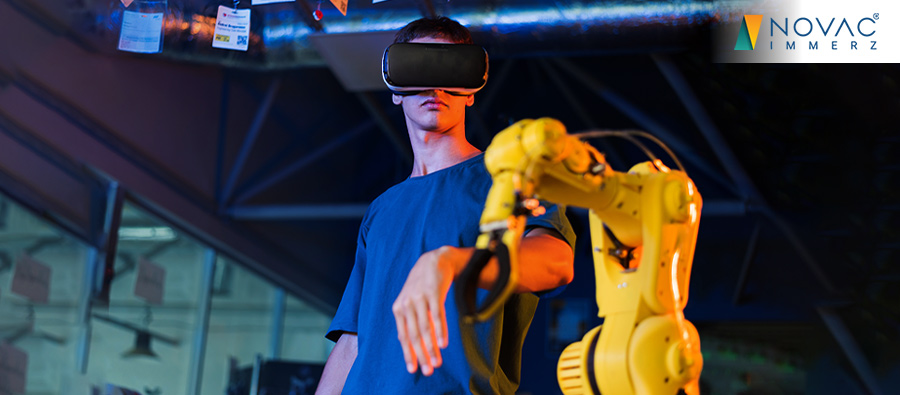Overview
Organizations ought to ensure the safety of their workforce. Providing adequate training to
employees will help prevent mishaps at the workplace. Compared to traditional
classroom-based methods, immersive technologies will create a simulated environment. Hence,
workers can practice emergency scenarios, safety procedures, and hazard identification
realistically. This will prepare them for complex and high-risk situations. Want to secure
your employees against impending disasters? It’s time to use AR VR in Safety Training.

Role of AR and VR in Safety Training
Industries like construction and manufacturing involve workers
performing tasks at heights. Lack of safety measures on overhead platforms and
workstations can result in injuries and deaths.
Augmented Reality
Solutions are highly effective for monitoring ladder safety, scaffolding,
usage of lifelines, and inspection of construction sites. Workers will be trained in
hazard recognition, inspection of protection equipment, and safety precautions.
Augmented Reality for Safety Training involves in-depth inspection of forklifts and
excavators. Simulators will help technicians understand the components of a forklift and
find flaws in vehicles. All the training scenarios are presented in photorealistic 3D
visuals. After a while, workers will be well-versed in hazard detection, emergency control,
and accident prevention.
Augmented Reality is the top choice for virtual training when workers
handle rigging equipment. Technicians will need to perform tasks such as lifting
hardware, inspecting gear, conducting overhead lifts, and examining lifting
equipment. AR will place workers in realistic scenarios for executing these tasks.
They can experience a life-size rigging rack, inspect it from different angles, and
move freely around the equipment. Subsequently, technicians can identify errors in
the rigging equipment.
Dangerous equipment is shut off. This reduces the chances of
accidents and injuries. Augmented Reality ensures that workers practice repetitively
in training sessions while dealing with hazardous energy. Technicians will become
proficient in identifying energy sources, utilizing different types of LOTO devices,
and the risks of inadequate management.

Augmented Reality will help create emergency simulations for industries like
construction, oil and gas, and logistics. Thus, workers can make the right decisions and
mitigate risks. The benefits include timely evacuation, compliance with safety standards,
and situational awareness.
Workers in factories and warehouses can identify risks arising from chemical
leaks and faulty equipment. Virtual Reality for Safety Training will test different aspects
like wearing personal protective equipment, identification and classification of potential
hazards, and corrective actions for hazards.
Safety inspections on various gas appliances can be conducted in virtual
reality. Workers can recognize Abnormal Operation Conditions (AOC). Later, they will perform
different tests like thermometer, flame, and lighting. Hence, technicians can determine the
condition of the gas appliance after thoroughly inspecting all the parts.
Virtual
Reality Solutions will enable simulation of an emergency response environment.
Workers will perform different steps like checking for breathing, assessing airways, chest
compression, contacting emergency services, and usage of automatic external defibrillators
(AED).
The AR and VR Safety Training Solutions of Novac Immerz
- Organizational Procedures
Comprehensive training is provided virtually to employees who handle the
equipment. This will help in creating a safe and injury-free environment. Further,
simulation-based training will create awareness about hygiene standards. Eventually, this
ensures that workers stay free from diseases.
There are several ways AR and VR can make Safety Training more effective.
Virtual reality in disaster management will help in enhancing first-responder operations. It
creates a realistic framework for natural disasters like earthquakes, floods, hurricanes,
tornadoes, tsunamis, and landslides through simulations.
The training sessions will mimic real-life scenarios. Our experts can create
AR and VR solutions for disaster education, preparedness, and management. Rehearsing
different scenarios will help workers perform real-life tasks accurately.
- Fire and Electrical Accident Management
Generally, industrial facilities and manufacturing firms are highly
vulnerable to fire accidents. AR VR in fire safety training will help create different
scenarios where employees can practice using portable fire extinguishers. This prevents
property damage, injuries, and death.
Our scenarios cover aspects like identification of fire-fighting equipment,
behavioral tendencies during fire situations, and inputs from fire safety professionals.
Hands-on VR fire safety training is offered to prevent injuries and extinguish the fire
within a limited period.
Poorly maintained electrical equipment can also result in fires and
explosions. Augmented Reality safety training will improve the efficiency and reliability of
electrical systems. Simulators will help workers in low-voltage electrical installation,
control of electrical equipment, and electrical installations. Employees will be aware of
protection measures and safety manoeuvres. Hence, they will be shielded from electrical
shocks and electrocution.
Employees can perform high-risk maintenance activities in a digitally
enhanced environment. They will get hands-on experience while repairing sensitive machinery.
AR and VR offer advantages like self-paced learning, risk-free training, and increased
retention of knowledge. Immersive technologies will enable a visual overlay of information
and workers can train using digital mockups. This ensures the smooth execution of different
types of maintenance like pre-determined, emergency, and corrective maintenance
Concluding Thoughts
On the whole, the immersive characteristics of Augmented Reality and Virtual Reality will
ensure that safety training can be performed in a hyper-realistic manner. 3D simulations
will enable better dispatch of information and instructions. In the long run, this will
result in reduced training costs, an increase in cognitive skills, and adequate exposure to
harmful situations.

Manicka Raja

Immersive tech pro with 8+ years of experience in VR/AR/MR development, game design, AI &
robotics. Passionate about mentoring and open-source contribution. Pioneering the path
for commercial ambient and spatial computing applications. Continuously pushing the
boundaries of AI and machine learning to craft intelligent XR experiences.









